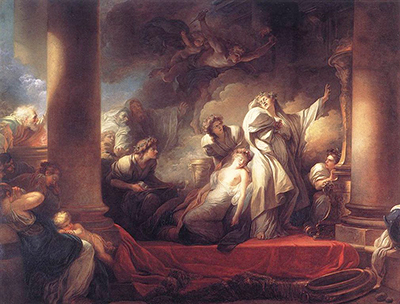Fragonard completed Coresus Sacrificing himself to Save Callirhoe in 1765 and this enormous canvas can be found amongst the Louvre's extensive collection of this artist's work.
The artist made use of one of the largest canvases in his career for this artwork, with this landscape-oriented artwork measuring four metres wide, and just over three metres tall. This amount of area allows the painter to go into the finest of detail on each of the figures within this painting, as well as adorning the rest of the scene with similarly complex work. Two tall pillars provide a vertical balance to the painting whilst in the background is a dramatic flurry of clouds and blue sky. Fragonard focuses one's eyes with an aggressive use of lighting, which predominantly captures the central figure who stands in the centre of the painting, just slightly to the right. The poses are dramatic, reminding us of historical art from previous centuries.
The artist is known to have produced a number of drawings in preparation for this complex artwork, though he even created one afterwards, as a means to remember the painting in an alternative form - that particular drawing is now owned by the Metropolitan Museum of Art, New York City. Those who are unaware of the meaning of this title can research a little in order to pinpoint and better understand different items in this painting. We do now know that Coresus was a high priest who knives himself in order to avoid any harm coming to Caillirhoe, his lover. She is believed to be the figure who lies to his right, although she has passed out in all the excitement.
The Louvre remains an incredible venue in which to appreciate art from some of the biggest names since the early Renaissance. Its connection to Fragonard begun with him rising up the ranks of French art, being accepted into the prestigious institutions that was necessary in order to promote your own reputation. He would finally be awarded his own room in the main gallery, where a number of his original works are rotated from time to time. Despite the huge area with which they have at their disposal, the sheer amount of art owned by the Louvre makes it a hard choice to decide what to display at any one time. To have his own room, therefore, underlines quite how respected Fragonard remains as an artist today.




